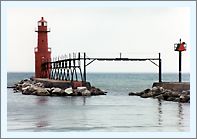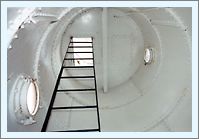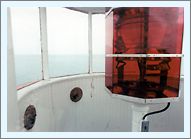|
Historical
Information

Ahnapee, an Indian
name for "land of the great gray wolf" was a growing fishing
town in 1871 when a fire swept from Green Bay, destroying thousands of
acres of land. Local residents prepared for the worst by waiting beside
boats on the lakefront with their valuables, planning on venturing out
into the lake to avoid the approaching flames. Fortunately, torrential
rains doused the fire at the last minute and saved the town.
Revitalized after their narrow escape, Ahnapee’s city fathers began
lobbying the Federal Government for funds to enlarge the town’s
harbor, which was home to a growing number of commercial fishing
vessels. Responding with back-to-back $25,000 appropriations in 1870 and
1871, the Army Corps of Engineers was dispatched to Ahnapee to construct
improved protective piers and begin dredging the river mouth. As a
direct result of these improvements, by 1879, Ahnapee’s commercial
fishing fleet had grown to become the largest on Lake Michigan, and the
town was formally renamed "Algoma," another Indian name,
meaning "park of flowers".
After pleas to the Federal Government for the erection of aids to
navigation at the harbor entrance went unheeded, local maritime
interests took matters into their own hands, establishing and
maintaining a couple of post lights at the outer ends of the piers.
Finally realizing the need to provide official illumination at Ahnapee,
Ninth District Engineer Major William Ludlow requested a surprisingly
low appropriation of $2,500 in his annual report for 1890 for the
construction of a pair of range lights on the north pier. In order to
keep the cost as low as possible, Ludlow’s plans called for a the
erection of a simple post light at the outer end of the north pier, and
the erection of a taller timber framed beacon approximately 200 feet
along the pier. Congress made the requested appropriation on March 3,
1891, however, with the Corps of Engineers in Algoma erecting a new
piers, work could not begin on the new ranges until completion of the
piers in late 1892.
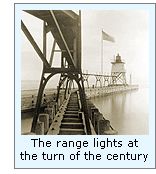 The new north pier on which the range was to be erected was of a
unique design, being both split and offset at its mid point. Since the
ranges were to be located on the detached outer pier section,
construction would necessarily begin with the erection of an elevated
bridge across the gap to provide access to the outer pier. A contract
for furnishing the prefabricated timber bridge was awarded to a ship
builder in Manitowoc, while work began on preparing the pier for the
installation of the bridge components on their arrival. Since the pier
would frequently be battered by waves over its surface, it was
imperative that the new timber components be anchored securely to the
piers. To this end, some of the stone within the pier cribs was removed,
and 12" square timbers were bolted to the crossties within the
cribs to serve as anchoring points for the bridge bents. On the arrival
of the bridge components from Manitowoc, the 10-foot tall bridge was
erected across the gap, and work began on the erection of the lights
themselves. The new north pier on which the range was to be erected was of a
unique design, being both split and offset at its mid point. Since the
ranges were to be located on the detached outer pier section,
construction would necessarily begin with the erection of an elevated
bridge across the gap to provide access to the outer pier. A contract
for furnishing the prefabricated timber bridge was awarded to a ship
builder in Manitowoc, while work began on preparing the pier for the
installation of the bridge components on their arrival. Since the pier
would frequently be battered by waves over its surface, it was
imperative that the new timber components be anchored securely to the
piers. To this end, some of the stone within the pier cribs was removed,
and 12" square timbers were bolted to the crossties within the
cribs to serve as anchoring points for the bridge bents. On the arrival
of the bridge components from Manitowoc, the 10-foot tall bridge was
erected across the gap, and work began on the erection of the lights
themselves.
To form the Front Range, an eighteen-foot tall post was erected at
the outer end of the pier, and a lens lantern placed atop the pole at a
focal plane of 22 feet. Thirty-three yards behind the front range, the
rear range light consisted of a typical timber framed skeletal pyramidal
pierhead beacon with its upper section enclosed to serve as both a
workroom and as shelter for the keeper during inclement weather. Capped
with a square timber gallery, a cast iron decagonal lantern was centered
on the gallery, also containing a lens lantern similar to that installed
on the Front Range. Standing 34 feet in height from the top of the pier
to the ventilator ball, the 80 candlepower rear range light sat at a
focal plane of 34 feet, and was visible for a distance of 9 miles at sea
in clear weather. Work on the new lights continued into December, with
the lights finally tested on December 23. With ice clogging the harbor,
the decision was made to delay exhibition of the lights until the
opening of the following navigation season.
Ole Hansen, a veteran of ten years lighthouse service who had most
recently been serving as Keeper of the Chicago Harbor Light was
appointed as Keeper of the new Light. Arriving in Ahnapee on February 14th,
1893, Hansen was likely surprised and dismayed to find that no dwelling
had been included in constructing the new station, and thus he was
forced to find rental housing in town. After moving into his new
"home," Hansen made his way out the pier to exhibit the new
lights for the first time on the evening of March 1, 1893.
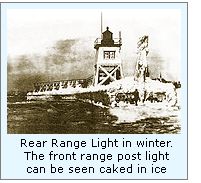 1894 saw the erection of a small wooden oil storage shed on shore at
the foot of the pier, and the rear range light was upgraded to a Fifth
Order Fresnel lens on June 5, 1895, with a resulting increase in its
range of visibility to 11 miles. Perhaps as a result of the lack of real
accommodations afforded by the station, Hansen accepted a transfer to
the Grassy Island Ranges in November of that same year. Hansen was
replaced by Charles E Young’ who transferred-in from Chambers Island
Light, and likely viewed stewardship of a station so close to town as an
improvement over the loneliness of island life, even without the
availability of proper quarters. While both Hansen and Young almost
certainly would have mentioned the lack of a dwelling to the District
Inspector during his visits to the station, their protestations were
ignored, as no steps were taken to improve the accommodations. To make
passage along the north pier safer during high seas, 400 feet of
elevated walk was installed on the pier in 1897. Charles Young accepted
a transfer to Menominee Pierhead in November 1899, with Nelson Knudsen
transferred-in from Beaver Harbor as is replacement. 1894 saw the erection of a small wooden oil storage shed on shore at
the foot of the pier, and the rear range light was upgraded to a Fifth
Order Fresnel lens on June 5, 1895, with a resulting increase in its
range of visibility to 11 miles. Perhaps as a result of the lack of real
accommodations afforded by the station, Hansen accepted a transfer to
the Grassy Island Ranges in November of that same year. Hansen was
replaced by Charles E Young’ who transferred-in from Chambers Island
Light, and likely viewed stewardship of a station so close to town as an
improvement over the loneliness of island life, even without the
availability of proper quarters. While both Hansen and Young almost
certainly would have mentioned the lack of a dwelling to the District
Inspector during his visits to the station, their protestations were
ignored, as no steps were taken to improve the accommodations. To make
passage along the north pier safer during high seas, 400 feet of
elevated walk was installed on the pier in 1897. Charles Young accepted
a transfer to Menominee Pierhead in November 1899, with Nelson Knudsen
transferred-in from Beaver Harbor as is replacement.
An additional 338 feet was added to the elevated walk in 1900, with
Knudsen now able to use the walk to make his way from the relative
protection of the harbor all the way out to the range. However, this
improvement was insufficient inducement to convince Knudsen to make
Ahnapee his long-term home, as he managed to arrange a swap of
assignments with Gustavus Umberham the Keeper of the Cedar River Light
after only a year and a half in Ahnapee.
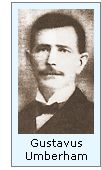 Umberham arrived in Ahnapee with his wife Anna on July 1, and grew to
be one of the best known and respected of all the Keepers assigned to
the Ahnapee Pierhead Light. Born in Green Bay on July 4, 1862, Gus
entered Lighthouse Service at the age of 19, after growing up working in
his father's commercial fishing business. After serving on Beaver Island
and Cedar River, he willingly accepted the transfer to Ahnapee, as it
put him within easy distance of his old home, and provided him the
opportunity to fish more often. Being a decent, hard working man, Gus
became both respected and liked throughout the community. Umberham arrived in Ahnapee with his wife Anna on July 1, and grew to
be one of the best known and respected of all the Keepers assigned to
the Ahnapee Pierhead Light. Born in Green Bay on July 4, 1862, Gus
entered Lighthouse Service at the age of 19, after growing up working in
his father's commercial fishing business. After serving on Beaver Island
and Cedar River, he willingly accepted the transfer to Ahnapee, as it
put him within easy distance of his old home, and provided him the
opportunity to fish more often. Being a decent, hard working man, Gus
became both respected and liked throughout the community.
Evidently, Umberham had greater success in convincing the District
Inspector of the dire need for a dwelling at the station. In 1902 the
Lighthouse Board requested that $3,500 be appropriated for the
construction of a dwelling at the station, reporting that "The
station is at quite a distance from any available dwelling, and on the
opposite side of the entrance to the harbor. A dwelling should be
provided for the keeper, that he may reside sufficiently near the lights
to give them proper care."
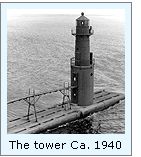 Unfortunately for Umberham, the request fell on deaf ears, as
Congress ignored the request, despite the Boards restatement of the need
for the appropriation in each of its annual reports for the following
six years. By 1907, the old wooden beacon was found to be in
significantly deteriorated condition, And while funds continued to be
unavailable for a new dwelling, the old wooden beacon was demolished,
and replaced by a cast iron cylindrical tower in 1908. Constructed of
5/16" steel plates, the tower was eight feet in diameter at the
base and tapered to seven feet in diameter beneath the gallery, and
stood twenty-six feet high to the top of the ventilator ball. The new
tower was capped by a decagonal cast iron lantern room, and outfitted
with the Fifth Order Fresnel lens from the old rear range beacon. Unfortunately for Umberham, the request fell on deaf ears, as
Congress ignored the request, despite the Boards restatement of the need
for the appropriation in each of its annual reports for the following
six years. By 1907, the old wooden beacon was found to be in
significantly deteriorated condition, And while funds continued to be
unavailable for a new dwelling, the old wooden beacon was demolished,
and replaced by a cast iron cylindrical tower in 1908. Constructed of
5/16" steel plates, the tower was eight feet in diameter at the
base and tapered to seven feet in diameter beneath the gallery, and
stood twenty-six feet high to the top of the ventilator ball. The new
tower was capped by a decagonal cast iron lantern room, and outfitted
with the Fifth Order Fresnel lens from the old rear range beacon.
Finally, sixteen years after the establishment of the station, an
appropriation was made for the construction of a dwelling, and a compact
hip-roofed house was erected on the hill on the north side of the river
overlooking the pier.
On February 3rd 1913, Gus and three other acquaintances accepted a
ride with a William Anderson who was taking his gasoline-engined boat
"RELIANCE" on a business trip to Kewaunee, where they planned
on stopping to eat supper before heading back to Algoma.
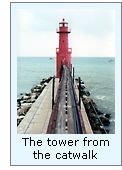 Leaving
Kewaunee shortly after 7.00pm, they headed out into the cold
black night, staying offshore in order to distinguish the Kewaunee and
Algoma lights, and maintain their bearings. The weather quickly
worsened, and with ice forming over the windows, they found it
increasingly difficult to see. When an unexpectedly large wave hit the
vessel, Gus must have lost his balance and fell on the side door.
Breaking the hooks holding the door closed, and falling overboard and
into the freezing blackness. Adamson heard the crash as the door broke
open, and yelled "is Gus there?" The others, also hearing the
crash, were unable to find Gus. Leaving
Kewaunee shortly after 7.00pm, they headed out into the cold
black night, staying offshore in order to distinguish the Kewaunee and
Algoma lights, and maintain their bearings. The weather quickly
worsened, and with ice forming over the windows, they found it
increasingly difficult to see. When an unexpectedly large wave hit the
vessel, Gus must have lost his balance and fell on the side door.
Breaking the hooks holding the door closed, and falling overboard and
into the freezing blackness. Adamson heard the crash as the door broke
open, and yelled "is Gus there?" The others, also hearing the
crash, were unable to find Gus.
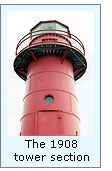 By the time Adamson managed to bring the RELIANCE about, Gus was
nowhere to be seen. They circled several times, and stopped the engine
to listen, but to no avail. After an hour of searching in the seething
lake, it was plain that Lake Michigan had claimed another victim in its
icy grasp. After returning to Algoma, Adamson had the enviable task of
informing Gus' wife Anna of the fate that had befallen her husband. The
people of Algoma were stunned by the news, and it was reported that a
"pall of gloom fell over the city." By the time Adamson managed to bring the RELIANCE about, Gus was
nowhere to be seen. They circled several times, and stopped the engine
to listen, but to no avail. After an hour of searching in the seething
lake, it was plain that Lake Michigan had claimed another victim in its
icy grasp. After returning to Algoma, Adamson had the enviable task of
informing Gus' wife Anna of the fate that had befallen her husband. The
people of Algoma were stunned by the news, and it was reported that a
"pall of gloom fell over the city."
Eugene V Kimball, a close acquaintance of Umberham made what was
likely a difficult decision to accept a transfer to Algoma from
Kewaunee, where he had been serving as keeper for twelve years to take
over for Umberham, assuming responsibility for the Algoma Light on
February 4.
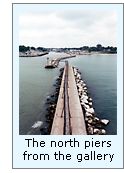 In order to render the light visible for a greater distance, a
twelve-foot tall cylindrical steel base was brought in from Muskegon in
1932, and installed on the pier. The old 1908 tower was then lifted and
secured on top of the cylinder, effectively increasing the tower's focal
plane to its current forty-two feet. Also at this same time, a $100,000
harbor improvement project was undertaken, which included capping both
the North and South piers with concrete, and the installation of
remotely controlled electrically operated diaphone fog signal on the
pier. In order to render the light visible for a greater distance, a
twelve-foot tall cylindrical steel base was brought in from Muskegon in
1932, and installed on the pier. The old 1908 tower was then lifted and
secured on top of the cylinder, effectively increasing the tower's focal
plane to its current forty-two feet. Also at this same time, a $100,000
harbor improvement project was undertaken, which included capping both
the North and South piers with concrete, and the installation of
remotely controlled electrically operated diaphone fog signal on the
pier.
As can be seen from the photograph at the top right, the fixed clear
Fresnel lens still shines from the tower, surrounded by a red glass
panels to impart a red signature.

Keepers of
this Light

Click here
to see a complete listing of all Ahnapee and Algoma
keepers compiled by Phyllis L. Tag of Great Lakes Lighthouse Research.

Finding this Light

From Highway 42, turn right (east) on to Clark Street. Take Clark Street
to Lake, and turn south on Lake. Turn into the parking area on the left,
and walk to the shore. The pier and light can be seen across the Ahnapee
River.

Reference Sources

 Inventory of Historic Light Stations, National Parks
Service, 1994 Inventory of Historic Light Stations, National Parks
Service, 1994
Algoma Public Library, Lighthouse vertical file.
Green Bay Press Gazette, 02/02/1983, 06/17/1993.
Algoma Record Herald, 06/14/1978.
Northern Lights, Charles K. Hyde,
1995
Photographs from author's personal collection.
Personal observation at Algoma, 09/10/2000
Information obtained from USCG
MK1 Sabo during visit to tower.
09/26/00 Email from MK1 Sabo
Keeper listings for this light appear courtesy of Great Lakes Lighthouse
Research
|
